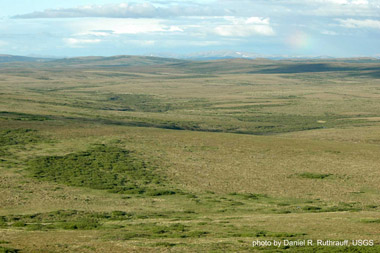Click on image for full size
Windows to the Universe original image
Related links:
Climate Changes with Latitude
Places located at high latitudes (far from the equator) receive less sunlight than places at low latitudes (close to the equator). The amount of sunlight and the amount of precipitation affects the types of plants and animals that can live in a place. The collection of all the living things in a place, as well as the non-living resources, is called an ecosystem or biome. Listed below are the types of ecosystems that exist in the climates of different latitudes.
The most sunlight is received at the equator of our planet, making this area very warm. The types of ecosystems that develop in this warm environment are:
- Rainforests: As the name suggests, rainforests receive a lot of rain. The temperature stays warm in the rainforest all year long.
- Savanna: This ecosystem has a wet season and a very dry season.
- Deserts: Deserts receive less rainfall than other tropical ecosystems but are just as warm.
The area between the warm tropics and the chilly poles is called the mid latitudes. Climates in this zone are affected by both warm, tropical air moving towards the poles and cold, polar air moving towards the equator.
- Chaparrel: This ecosystem has wet-winters and dry-summers.
- Grasslands: This ecosystem is typically found on the dry interior of continents.
- Temperate forest: A moist climate allows leafy deciduous trees to thrive.
High latitudes receive the least sunlight, creating cold climates.
- Taiga: The forests of the taiga ecosystem survive despite long and very cold winters. Summers are short and still quite cool.
- Tundra: Ocean winds in arctic
coastal areas keep the temperatures from being as severe as interior regions.
A long, chilly winter season is followed by a mild season.















